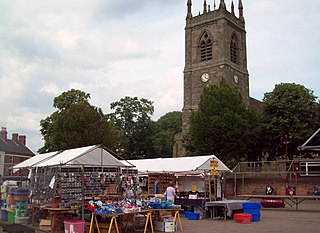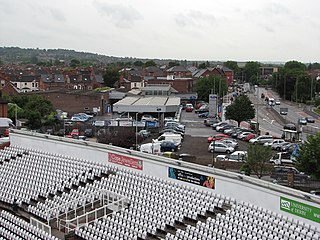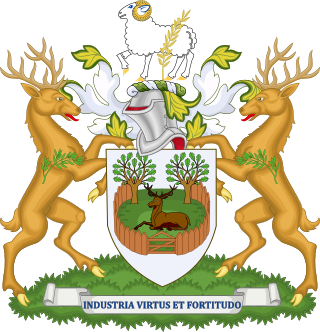
Nottinghamshire is a ceremonial county in the East Midlands of England. The county borders South Yorkshire to the north-west, Lincolnshire to the east, Leicestershire to the south, and Derbyshire to the west. The largest settlement is the city of Nottingham (323,632).

Melton is a local government district with borough status in north-eastern Leicestershire, England. It is named after its only town, Melton Mowbray. The borough also includes numerous villages and surrounding rural areas. The north of the district includes part of the Vale of Belvoir. Melton is the least populous district of its type and the fourth least populous district in England overall.

Erewash is a local government district with borough status in Derbyshire, England. The borough is named after the River Erewash. The council has offices in both the borough's towns of Ilkeston and Long Eaton. The borough also includes several villages and surrounding rural areas. Some of the built-up areas in the east of the borough form part of the Nottingham Urban Area.

Bassetlaw is a local government district in north Nottinghamshire, England. Its council is based in the town of Worksop; the other towns in the district are Retford, Tuxford and Harworth Bircotes. The district also contains numerous villages and surrounding rural areas.

Broxtowe is a local government district with borough status in Nottinghamshire, England. It lies immediately west of the city of Nottingham, and most of the built-up areas of the borough form part of the Nottingham Urban Area. The council is based in Beeston and the borough also includes the towns of Eastwood, Kimberley and Stapleford and surrounding villages and rural areas.

Rushcliffe is a local government district with borough status in south Nottinghamshire, England. Its council is based in West Bridgford. The borough also includes the towns of Bingham and Cotgrave as well as numerous villages and surrounding rural areas. Some of the built-up areas in the north-west of the borough, including West Bridgford, form part of the Nottingham Urban Area.

Gedling is a local government district with borough status in Nottinghamshire, England. The council is based in Arnold. The borough also includes Carlton along with villages and rural areas to the north-east of Nottingham. The main built-up part of the borough around Arnold and Carlton forms part of the Nottingham Urban Area.

Dudley Metropolitan Borough Council is the local authority for Dudley metropolitan borough. It is more commonly known as Dudley Council or Dudley MBC.

Mansfield District is a local government district in Nottinghamshire, England. It is named after the town of Mansfield, where the council is based. The district also contains Mansfield Woodhouse and Warsop.

Nottingham City Council is the local authority for Nottingham, a unitary authority with city status. Nottingham is in the ceremonial county of Nottinghamshire, England, but as a unitary authority the city council is administratively independent from the surrounding Nottinghamshire County Council. The city council consists of 55 councillors, representing a total of 20 wards, elected every four years. The council is led by Neghat Khan, of the majority Labour Party. The council is a constituent member of the East Midlands Combined County Authority.

Derbyshire County Council is the upper-tier local authority for the non-metropolitan county of Derbyshire in England. The non-metropolitan county is smaller than the ceremonial county, which additionally includes Derby. The county council is based at County Hall in Matlock. Since 2017 the council has been under Conservative majority control. The council is a constituent member of the East Midlands Combined County Authority.

City of Bradford Metropolitan District Council is the local authority of the City of Bradford in West Yorkshire, England. It is a metropolitan district council, one of five in West Yorkshire and one of 36 in the metropolitan counties of England, and provides the majority of local government services in Bradford. Since 2014 it has been a constituent member of the West Yorkshire Combined Authority.

Derby City Council is the local authority for Derby, a unitary authority with city status in the East Midlands region of England.
Rushcliffe Borough Council elections are held every four years. Rushcliffe Borough Council is the local authority for the non-metropolitan district of Rushcliffe in Nottinghamshire, England. Since the last boundary changes in 2023 the council has comprised 44 councillors representing 24 wards, with each ward electing one, two or three councillors.
Gedling Borough Council elections are held every four years. Gedling Borough Council is the local authority for the non-metropolitan district of Gedling in Nottinghamshire, England. Since the last boundary changes in 2015, 41 councillors have been elected from 19 wards.

Wakefield Council, formally the City of Wakefield Metropolitan District Council, is the local authority of the City of Wakefield in West Yorkshire, England. Wakefield is a metropolitan borough with city status. The council and provides a full range of local government services including Council Tax billing, libraries, social services, town planning, waste collection and disposal, and it is a local education authority. Wakefield is divided into 21 wards, electing 63 councillors. A third of the council is elected for three of every four years.

Barnsley Metropolitan Borough Council is the local authority of the Metropolitan Borough of Barnsley in South Yorkshire, England. Barnsley is a metropolitan borough, one of four in South Yorkshire, and provides the majority of local government services in Barnsley. The council is a constituent member of the South Yorkshire Mayoral Combined Authority.

Calderdale Metropolitan Borough Council is the local authority for the Metropolitan Borough of Calderdale in West Yorkshire, England. The council styles itself Calderdale Council. It is a metropolitan district council, one of five in West Yorkshire and one of 36 in the metropolitan counties of England. It provides the majority of local government services in Calderdale. Since 2014 the council has been a constituent member of the West Yorkshire Combined Authority.

South Tyneside Council is the local authority of for the metropolitan borough of South Tyneside in the ceremonial county of Tyne and Wear in North East England. It is one of five metropolitan boroughs in Tyne and Wear and one of 36 in England. It provides the majority of local government services in South Tyneside. The council has been under Labour majority control since 1979. It is based at South Shields Town Hall. The council is a constituent member of the North East Mayoral Combined Authority.

The Borough of Chesterfield is a non-metropolitan district with borough status in Derbyshire, England. It is named after the town of Chesterfield, its largest settlement, and also contains the town of Staveley and the large village of Brimington.






















